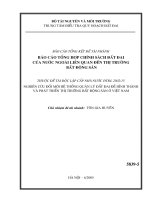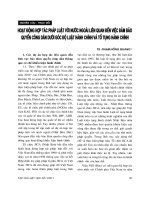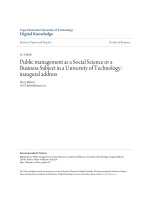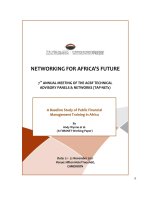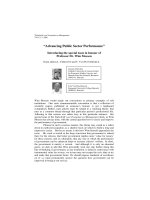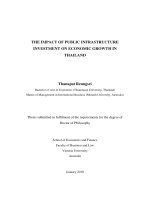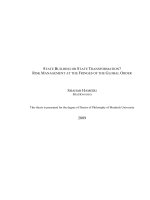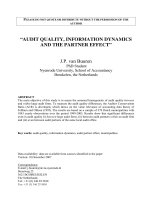Whole luận án tiến sỹ của tác giã nước ngoài liên quan đến đề tài về kiểm toán
Bạn đang xem bản rút gọn của tài liệu. Xem và tải ngay bản đầy đủ của tài liệu tại đây (1.86 MB, 301 trang )
STATE BUILDING OR STATE TRANSFORMATION?
R
ISK MANAGEMENT AT THE FRINGES OF THE GLOBAL ORDER
S
HAHAR HAMEIRI
BA
(H
ONOURS
)
This thesis is presented for the degree of Doctor of Philosophy of Murdoch University
2009
v
Abstract
This thesis develops a new framework for explaining the effects and possible
trajectories of state building interventions (SBIs). This is for both examining specific
interventions and learning about the precise nature of the post-Cold War global order –
how power is distributed, exercised, constrained and challenged within and between
states.
In the post-Cold War years, but particularly since the September 11 2001
terrorist attacks, so-called failed states have become a central security concern for
policymakers. In tandem, there has been an influx of practitioner and scholarly interest
in international ‘state building’. Prevalent approaches to state building are premised on
a static conception of the state and therefore seek to evaluate SBIs in terms of whether
they help create ‘more’ or ‘less’ state. In contrast, this thesis examines SBIs as a new
mode of governance in the global political economy that is transformative of both
intervened and intervening states, leading to the creation of a transnationalising and
transnationally regulated form of statehood. Based on a conception of the state as a site
of social and political struggle this study examines the ways in which SBIs affect the
distribution, production and reproduction of political power in intervened states: Who
rules and how? What social and political conflicts are engendered or exacerbated by
SBIs, and how are they managed? What alliances and coalitions support the
production/reproduction of power relationships associated with SBIs?
The thesis provides a conceptual framework for understanding the complex
governance terrain SBIs open up. SBIs are conceptualised as multilevel regimes – sets
of social and political relationships, institutions and ideas – that exist simultaneously
within and outside intervened states. While preserving the formal sovereignty of
intervened states, these regimes are nevertheless established to shape political outcomes
by limiting the political choices available to domestic leaders. This is operationalised by
opening up and shifting power to multilevel spaces of governance within the apparatus
of these countries. Through case studies from Australia, Solomon Islands and
Cambodia, the thesis analyses the politics of SBIs and their broader implications for
contemporary statehood. Ultimately it establishes that regardless of whether SBIs are
successful or otherwise in achieving their stated objectives they are associated with the
emergence of increasingly authoritarian, hierarchical and anti-competitive forms of
political rule, both within and between states.
vi
Table of Contents
Abstract v
Table of Contents vi
Abbreviations viii
Acknowledgements xi
Introduction 1
Case study selection and approach
8
Chapter One
Contemporary Approaches to State Building and Their Limitations:
Towards a New Framework 13
Introduction
13
Evaluating the effects of state building interventions: Current debates and their
limitations
15
The capacity building debate
16
The sovereignty debate
31
State building interventions: towards a new approach
40
Conclusion
45
Chapter Two
State Building Interventions as Risk Management: State
Transformation and Multilevel Regimes 47
Introduction
47
Risk management and state transformation
49
State building interventions as multilevel regimes: conceptual and theoretical
issues
57
State building and legal exceptionalism: the ever-changing demands of risk
management
69
Conclusion
74
Chapter Three
The Emergence of State Building: State Transformation and the
Globalisation of Risk 77
Introduction
77
The failure of the humanitarian interventions of the early 1990s
81
The return to the state in development theory and policy
88
Neoliberalism and the transformation of Western states
96
The globalisation of risk and the localisation of risk management
104
Conclusion
110
Chapter Four
Who Intervenes and Why? State Transformation and Meta-
Governance 113
Introduction
113
Actors and multilevel regimes
117
Public actors in state building interventions
124
Private actors in state building interventions
127
vii
Nongovernmental organisations
130
Consultants
135
Private Military Companies and the Privatisation of Security
138
Conclusion
141
Chapter Five
The Australian Federal Police and the (Meta) Governance of Disorder
in the Australian State’s New Regional Frontier 143
Introduction
143
The Australian state and the Australian Federal Police
146
The neoliberalisation of the Australian state: disaggregation and new modes of
coordination
147
Whole of government and the Australian national security apparatus
151
The AFP’s new policy role and accountability requirements
153
The International Deployment Group and the Australian state’s new frontiers
159
The contours of the Australian state’s regionalisation
160
The AFP and Australian regionalisation
168
IDG operations and the limits to regulatory regionalisation in practice
171
Conclusion
175
Chapter Six
The Regional Assistance Mission to Solomon Islands: State
Transformation and Its Limitations 179
Introduction
179
RAMSI and its critics
182
State transformation and RAMSI: politics as risk, anti-politics as risk
management
194
The limits to RAMSI’s state transformation: bringing politics back in
207
Conclusion
216
Chapter Seven
One State, Two Regimes, No Conflict? Patronage, State Building, and
the Anti-Pluralist Politics of Stability in Cambodia 219
Introduction
219
Cambodia’s regime of ‘transformed’ patronage
223
International intervention and political liberalisation in Cambodia
232
State building in Cambodia: good governance, coordination and the
consolidation of Hun Sen’s rule
239
Conclusion
253
Conclusion 255
Bibliography 261
viii
Abbreviations
ADB Asian Development Bank
ADF Australian Defence Force
AFP Australian Federal Police
ANU Australian National University
ASEAN Association of Southeast Asian Nations
ASIO Australian Security Intelligence Organisation
ASOSAI Asian Association of Supreme Audit Institutions
AusAID Australian Agency for International Development
BiH Bosnia and Herzegovina
CDC Council for the Development of Cambodia
CDCF Cambodia Development Cooperation Board
CG Consultative Group
CGDK Coalition Government of Democratic Kampuchea
C I V P O L Civilian Police
COAG Council of Australian Governments
C P I A Country Policy and Institutional Assessment
CPP Cambodian People’s Party
CPR Conflict Prevention and Reconstruction Unit
CRDB Cambodia Rehabilitation and Development Board
DAC Development Assistance Committee
Danida Danish International Development Agency
DFAT Department of Foreign Affairs and Trade
DfID Department for International Development
ECP Enhanced Cooperation Program
EPG Eminent Persons Group
ERU Economic Reform Unit
EU European Union
FIA Facilitation of International Assistance
FUNC INP EC Front Uni National pour un Cambodge Indépendent, Neutre, Pacifique
et Coopératif
HNP Haiti National Police
GAP Governance Action Plan
ix
GDCC Government-Donor Coordination Committee
GDP Gross domestic product
GEMAP Governance and Economic Management Assistance Program
GTZ German Technical Cooperation
ICC International consultancy company
ICIS S International Commission on Intervention and State Sovereignty
ICRC International Committee of the Red Cross
IDC Interdepartmental committee
IDG International Deployment Group
IFI International financial institution
IFM Isatabu Freedom Movement
IMF International Monetary Fund
INGO International nongovernmental organisation
INTOS AI International Organisation of Supreme Audit Institutions
JMI Joint monitoring indicators
KPNLF Khmer People’s National Liberation Front
LICU S Low-income countries under stress
MEF Malaita Eagle Force
MINUSTAH United Nations Stabilisation Mission in Haiti
MoFT Ministry of Finance and Treasury
NAA National Audit Authority
NIE New Institutional Economics
NGO Nongovernmental organisation
NPM New public management
NSC National Security Committee of Cabinet
NSS National Security Strategy
NT Northern Territory
OAG Office of the Auditor-General
ODA Official development assistance
OECD Organisation for Economic Cooperation and Development
PAC Public Accounts Committee
PGSP Pacific Governance Support Program
PIF Pacific Islands Forum
P I U Project implementation unit
x
PM&C Department of the Prime Minister and Cabinet
PMC Private military company
PNG Papua New Guinea
PPF Participating Police Force
PRAN Pacific Regional Assistance to Nauru
PRPK People’s Revolutionary Party of Kampuchea
PSC Private security company
PSRP Public Sector Restructuring Program
PWC Post-Washington Consensus
R A M S I Regional Assistance Mission to Solomon Islands
RCAF Royal Cambodian Armed Forces
R S I P Royal Solomon Islands Police
SAP Structural adjustment program
SBI State building intervention
SCNS Secretaries Committee on National Security
S/CRS Coordinator for Reconstruction and Stabilization
SOE State-owned enterprise
SPASAI South Pacific Association of Supreme Audit Institutions
SRP Sam Rainsy Party
SSR Security sector reform
TNC Transnational corporation
TPA Townsville Peace Agreement
TWF Technical Working Group
UN United Nations
UNDP United Nations Development Programme
UNSC United Nations Security Council
UNTAC United Nations Transitional Authority in Cambodia
US United States
USAID United States Agency for International Development
WofG Whole of government
xi
Acknowledgements
When I submit this thesis only one name will be printed under the (admittedly long)
title. However, it would not have come about without the support, knowledge and
energy of the people mentioned below. It is often said that writing a thesis is a lonely
task, but I am glad to say that my experience has been a different one. The past three
years have been exceptionally eventful. In February 2007 my wife, Meggan, and I
celebrated the birth of our firstborn son, Joshua, while in July 2008, we were overjoyed
at the arrival of his brother, Theo. Somehow, between dirty nappies and sleepless nights
I managed to write a thesis and a few articles, and have some fun in the process too!
It is difficult to overestimate the importance of academic supervisors to thesis-
writing. I feel that I have been particularly fortunate to have on my side two fantastic
supervisors, Professor Garry Rodan and Dr Kanishka Jayasuriya. For Garry and
Kanishka academic work is not a job, but a vocation. Their genuine intellectual
curiosity and rigour have been truly inspirational to this young(ish) would-be academic.
Garry and Kanishka did more then help me write a thesis – they welcomed me into an
intellectual community and made me feel part of the team from day one. I cannot count
the number of times we chatted casually in the corridor about work-related and other
issues. Few postgraduates have had a similar relationship with their academic
supervisors. For all they have done to make this thesis happen and make me the
researcher I am today, I am deeply grateful.
There are numerous colleagues that I would like to thank for their help in
preparing the thesis and, perhaps more importantly, for their friendship. At the Asia
Research Centre, my intellectual home for the past four years (I also wrote my honours
thesis under the supervision of Professor Rodan and worked as a research assistant in
the Centre), I would like to acknowledge Dr Toby Carroll, Dr Ian Wilson, Dr Sid
Adams, Dr Jane Hutchison, Dr Caroline Hughes, Professor Richard Robison, Dr Carolin
Liss, Stuart Latter, Dr Miyume Tanji, Martin Gwyn-Fawke and David Flynn. A special
mention is reserved to the Centre’s administrative officer, Tamara Dent, for her
commitment to making the university’s impenetrable bureaucracy more manageable to
postgrads. Most importantly, however, Tamara has helped me keep my sanity in the
final days by assisting with thesis layout and formatting. Outside the Asia Research
Centre, I would like to acknowledge fellow Murdoch University postgraduate students
and good friends William Clapton, Katie Atwell and Dave Mickler. Beyond Murdoch
xii
University I would like to mention Dr Marcos Berger, Dr Andrew Rosser, Jan
Bachmann, Grant Walton and Dr Sinclair Dinnen. I apologise to numerous other
colleagues from around the world who could not be mentioned in name due to the
scarcity of space.
In the course of my fieldwork trips to Solomon Islands, Canberra and Cambodia,
many people – too many to mention here – went out of their way to help me develop m y
research. I am indebted to the RAMSI officials, AFP officers, NGO workers,
bureaucrats, journalists, politicians, development practitioners and many others, who
took time to talk to me – without whom this thesis would have been impossible to write.
I would particularly like to mention my dear friend Willie Atu, from Naha, Solomon
Islands, who graciously welcomed me into his wonderful family and community.
Finally, I would not be where I am today without my family. My Ima and Aba,
Sara and Ze’ev Hameiri, from Netanya, Israel, instilled in me a love of knowledge and
learning from a very young age and have always supported me in all my endeavours.
My brother, Boaz, too, has always been there for me. I am also greatly indebted to my
father- and mother-in-law, John and Kathleen Colley, who have helped me in so many
ways I could not possibly hope to ever repay. My beautiful boys, Joshua and Theo,
deserve a special mention, not because they helped me with the thesis (quite the
contrary is true…), but for enriching my life and making me happier way beyond any
scholarly achievement.
The last person I would like to thank on these pages deserves my deepest
gratitude. My wife, Meggan, is the one that started me on the path to this PhD years
ago, and even though she might have come to regret it a couple of times (or more…) I
hope she is proud now. Meggan has always reminded me what life is all about and has
filled my days with love and joy. For that I am eternally grateful.
Shahar Hameiri
Perth, Western Australia, January 2009.
I
NTRODUCTION
1
Introduction
In the post-Cold War years, but particularly since the September 11 2001 terrorist
attacks in the United States (US), the postcolonial state and the functioning of its
institutions have become primary security concerns for policymakers in the world’s
major states and multilateral organisations. Initially, failed and fragile states were
viewed mainly in relation to humanitarian crises, economic development prospects and
human rights violations. However, in the course of the 1990s they have come to be seen
as constituting considerable risk to states and societies many kilometres away, due to
the perception that the absence or poor functioning of governance structures of a
particular kind increases the likelihood of transnational risks, such as terrorism,
international crime, environmental degradation and disease, to fester unchecked within
their borders and eventually migrate elsewhere.
Indeed, for many renowned policymakers and public intellectuals, effective
global action to tackle governance ‘black holes’ and build/rebuild failed or fragile states
is seen as one of the most pressing issues on the world’s agenda for the twenty-first
century. The September 2002 US National Security Strategy paper turned conventional
strategic thinking on its head when it stated that: ‘America is now threatened less by
conquering states than we are by failing ones.’
1
Former United Nations (UN) Secretary
General Kofi Annan said that ‘ignoring failed states creates problems that sometimes
come back to bite us.’
2
Political scientist Francis Fukuyama, who famously proclaimed
the post-Cold War era as heralding the ‘end of history’,
3
has argued more recently in a
less triumphant mood that ‘state-building is one of the most important issues for the
world community because weak or failed states are the source of many of the world’s
most serious problems, from poverty to AIDS to drugs to terrorism.’
4
Robert Rotberg
posited that state building was ‘one of the critical all-consuming strategic and moral
imperatives of our terrorized time.’
5
Afghanistan’s first post-intervention Finance
Minister, Ashraf Ghani, and co-author Clare Lockhart have summarised the prevailing
1
White House, ‘National Security Strategy of the United States’, Washington DC: White House,
September 2002, p. 1.
2
Annan, Kofi, ‘Transcript of Press Conference by Secretary-General Kofi Annan at United Nations
Headquarters’, United Nations, 21 March 2005, available at
< accessed 31 October 2008.
3
Fukuyama, Francis, The End of History and the Last Man (London: Penguin, 1992).
4
Fukuyama, Francis, State-Building: Governance and World Order in the Twenty-First Century
(London: Profile Books, 2005), p. xvii.
5
Rotberg, Robert I., ‘The Failure and Collapse of Nation-States: Breakdown, Prevention and Repair’, in
When States Fail: Causes and Consequences, edited by Robert I. Rotberg (N e w Princeton: Princeton
University Press, 2004), pp. 1-45, p. 42.
I
NTRODUCTION
2
sentiment in claiming: ‘A consensus is now emerging that only sovereign states—b y
which we mean states that actually perform the functions that make them sovereign—
will allow human progress to continue.’
6
As such, there has been a massive influx of practitioner and scholarly interest in
developing suitable and successful approaches to international state building. State
building has to a considerable extent come to replace or greatly transform the earlier
concern in the post-Cold War era with ‘building’ the ‘peace’ in post-conflict states and
societies.
7
Peacebuilding initially referred to interventions and programs intended to
turn violent conflict into peace. In contrast, state building is a term commonly used to
refer to the broad range of programs and projects designed to build or strengthen the
capacity of institutions, organisations and agencies – not all of which are necessarily
part of the state apparatus – to effectively perform the functions associated with modern
statehood. While state building interventions (SBIs) are in some cases deployed to deal
with violent conflict on a large scale,
8
this is not a precondition as state building has
taken on a more pre-emptive, risk management, form than earlier post-Cold War
interventions.
9
Indeed, the state building agenda has now been extended beyond ‘post-
conflict’ situations to be regarded as ‘applicable to a wide spectrum of developing
countries, both in war and peace.’
10
This study has emerged out of dissatisfaction with existing accounts of
contemporary state building and its effects. As I elaborate in the first chapter, most
approaches to the examination of state building, whether critical or otherwise, implicitly
accept the premise that these interventions are, or should be, about building the capacity
of the state to govern domestically. Therefore, the literature has tended to conceive and
evaluate SBIs in terms of their effects on state capacity and institution building, or in
some cases on state sovereignty. Such perspectives are established upon static
6
Ghani, Ashraf and Clare Lockhart, Fixing Failed States: A Framework for Rebuilding a Fractured
Wor l d (Oxford: Oxford University Press, 2008), p. 4.
7
Bendaña, Alejandro, ‘From Peace-Building to State-Building: One Step Forward and Two Backwards?’,
paper presented at the Nation-Building, State-Building and International Intervention: Between
'Liberation' and Symptom Relief, Paris, 15 October 2004.
8
See Barnett, Michael, Hunjoon Kim, Madalene O’Donnell and Laura Sitea, ‘Peacebuilding: What is in a
Name?’, Global Governance 13, no. 1 (2007), pp. 35-58.
9
As Oliver Richmond notes, peace has recently become synonymous with governance and the existence
of governance structures of a particular kind. In this sense, the meaning of peacebuilding and state
building has largely merged. Richmond, Oliver, The Transformation of Peace (Basingstoke: Palgrave
Macmillan, 2005), p. 69.
10
Bickerton, Christopher J., ‘State-Building: Exporting State Failure’, in Politics without Sovereignty: A
Critique of Contemporary International Relations, edited by Christopher J. Bickerton, Philip Cunliffe
and Alexander Gourevitch (London: University College Press, 2007), pp. 93-111, p. 93.
I
NTRODUCTION
3
institutional, legal and procedural conceptions of statehood and thus tend to mask the
inherently political and ideological underpinnings of all projects of state construction
and reconstruction, whether internally or externally driven, as well as the conflict-ridden
and dynamic nature of such processes. They also reify rigid dichotomies, such as
domestic-external, state-society, formal-informal and public-private, that are drawn
along formal institutional and jurisdictional lines. By focusing on the links between
state building and capacity building, state building and sovereignty, or indeed capacity
and sovereignty, the literature on state building misses the crucial political nature of
contemporary SBIs – the ways in which they affect the distribution, production and
reproduction of political power in intervened states – and is therefore unable to explain,
rather than describe, the possible trajectories of such interventions.
In contrast, I begin from the premise that the state is not an amalgam of
institutions and actors governing a particular territory, but a site of social and political
conflict.
11
I argue that SBIs represent a new mode of governance, or a new form of
political rule, that rather than merely build the capacity of the state, is in actual fact
transforming the very nature of statehood in both intervened and intervening countries,
leading to the emergence of a transnationalising and transnationally regulated state. This
new, complex and contested form of statehood does not find adequate expression within
traditional readings of international relations and international law and its true nature is
obfuscated by the prevailing methodological nationalism of existing accounts of state
building, which take the state as a given and its ‘performance’ as their object of enquiry.
Contemporary SBIs are premised on the perception that the absence or poor
functioning of domestic governance institutions of a particular kind represents an
unacceptable security risk to the intervening states and their societies. Therefore,
managing risk in the longer term is seen to require the ‘strengthening’, indeed the
transformation, of domestic governance structures and their outputs in intervened states.
However, despite the ambitious and far-reaching nature of such objectives, their
implementation does not involve directly ruling intervened states. Rather, SBIs are set
up to shape political outcomes primarily by circumscribing the spectrum of political
choices available to domestic leaders, by means of transforming intervened states from
within; that is, they seek to shift policymaking into transnationalised spaces of
11
Poulantzas, Nicos, Political Power and Social Classes, Translated by Timothy O'Hagan, David
McLellan, Anna de Casparis and Brian Grogan (London: Ne w Left Books and Sheed and Ward 1973
[1968]); Jessop, Bob, State Theory: Putting the Capitalist State in Its Place (Cambridge: Polity Press,
1990).
I
NTRODUCTION
4
governance opened up within or near the domestic governance apparatus of intervened
states and into the hands of experts and managers who are not politically or popularly
accountable. While such emerging governance arrangements are inherently hierarchical,
in that they are structured to preference particular political outcomes and interests over
others, SBIs almost without exception preserve the formal-legal sovereignty and
territorial integrity of intervened states. Indeed, SBIs are also found outside the state, in
the shape of more traditional forms of diplomatic-international interactions between
sovereign governments or multilateral organisations. This unique ‘multilevel’ character
of SBIs – simultaneously within and without the state – is important to understand and
theorise in order to make sense of the potential trajectories of particular interventions
and the broader implications of this mode of governance for the emerging global order.
Crucially, rather than manifestations of an already consolidated post-Cold War
global order – defined by either Westphalian pluralism or new imperialism – SBIs are
part of the very process by which this global order is being defined, resisted, extended
and modified. Because this process is very much contested, learning about the nature,
scope, trajectories, and most importantly, the limitations of interventions in the world’s
‘fringes’
12
is a particularly useful way of understanding the dynamics of the emerging
post-Cold War global order and its implications for states, societies and political agency
more broadly. Indeed, this study demonstrates that SBIs are dynamic and often
innovative forms of rule that can produce political outcomes that greatly diverge from
those anticipated by their planners and implementers. This ‘inside-out’ approach stands
in contrast to more prevalent ‘outside-in’ approaches, that seek to understand
interventions and interventionism in relation to pre-conceived and static conceptions of
the global order and national politics.
Examining SBIs as a novel form of political rule – or a new mode of governance
– that complicates traditional conceptions of statehood throws up a set of questions that
is mostly overlooked by the prevailing tendency to examine these interventions in terms
12
I use the term ‘fringes’ in a similar manner to Mark Duffield’s usage of ‘borderlands’ in: ‘Social
Reconstruction and the Radicalization of Development: Aid as a Relations of Global Liberal
Governance’, in State Failure, Collapse and Reconstruction, edited by Jennifer Milliken (Malden:
Blackwell Publishing, 2003), pp. 291-312. ‘Fringe’ is not merely a geographical attribute, relating to
so-called failed and rogue states, but something that can potentially refer to pockets of ‘illegitimate’
activity within or across the territorial borders of Western states as well, such as terrorist cells and
illegal migrants. In recent years, some of these security threats have been dealt with outside the usual
legal rules and procedures. Jayasuriya defines this as a ‘global state of exception’. See Jayasuriya,
Kanishka, Reconstituting the Global Liberal Order: Legitimacy and Regulation (London and New
York: Routledge, 2005).
I
NTRODUCTION
5
of their institutional outputs at the national or in some cases sub-national levels of
governance. This thesis sets out to explicitly examine the ways in which SBIs affect the
production/reproduction and distribution of political power in intervened states: Who
rules? How do they rule? What social and political conflicts are engendered or
exacerbated by SBIs, and how are they managed? And finally, what alliances and
coalitions support or resist such power relations?
13
It is structured to address these
issues by developing a theoretical and conceptual framework for examining
contemporary SBIs, as well as providing three case studies that each examine a different
dimension of the ways in which these interventions transform the state.
After critically evaluating the existing literature on state building and outlining
the theoretical premises of the thesis in Chapter One, I proceed in Chapter Two to
provide a conceptual framework for understanding the complex governance terrain
opened up by SBIs and its relationships with other levels of governance, above and
below the state. SBIs are conceptualised as multilevel regimes – sets of social and
political relationships, institutions and ideas – that exist simultaneously inside and
outside intervened states. However, SBIs never operate in a social and political vacuum
– intervention regimes tend to coexist and come into conflict with other regimes within
the state, which have different support-bases and ideational underpinnings. Such
conflicts may have transformative effects on all regimes within the state and hence on
the nature of emergent forms of political rule.
In Chapter Three I examine the historical conjuncture within which this form of
intervention has emerged. Four interrelated historical developments are identified as
particularly pertinent – the perceived failure of the UN-led humanitarian interventions
of the 1990s; the evolution in market-led approaches to development towards greater
focus on the state and the quality of institutions as determinants of successful
development outcomes; the ongoing transformation of the Western state after three
decades of neoliberalisation, and the associated shift away from government and the
politics of interest-representation to governance and the politics of values; and finally,
the supposed emergence of existential global-transnational risks and the reorientation of
policymaking towards managing and containing risks of various kinds. By relating SBIs
13
The development of this set of questions has been influenced by Snyder’s critique of the
democratisation literature’s obsession with examining and evaluating the institutional outputs of
regimes, while neglecting more fundamental questions such as those relating to the nature of political
rule. Snyder, Richard, ‘Beyond Electoral Authoritarianism: The Spectrum of Nondemocratic Regimes’,
in Electoral Authoritarianism: The Dynamics of Unfree Competition, edited by Andreas Schedler
(Boulder: Lynne Rienner, 2006), pp. 219-31.
I
NTRODUCTION
6
to broader historical processes the third chapter demonstrates that contemporary SBIs
are not exceptional responses to crisis situations, reflecting localised lapses in state
capacity and governance, but a new and dynamic mode of governance in the global
political economy that is transforming the state from within, rather than from the
outside. In this way SBIs constitute an important pillar in the architecture of an
emerging anti-pluralist, hierarchical and increasingly authoritarian liberal global order.
In the fourth chapter I proceed to examine more closely the political and
ideological nature of SBI regimes, by interrogating the relationship between processes
of state transformation in intervening states, the kinds of actors – public and private –
that participate in these interventions and their functions. In particular, I focus in
Chapter Four on the role of what I call meta-governance actors, who are often
concentrated in the core executive of states and multilateral organisations, in providing
the broad set of rules that structure diffuse multilevel regimes. As the discussion in
Chapter Four makes clear, whether public power is in the hands of public or private
actors is less significant than the shifts in the location and purpose of state power that
we have seen through ongoing processes of state transformation-neoliberalisation.
These shifts have led to the reframing of public policy, not as an inherently political
matter pertaining to conflicts between competing and often irreconcilable interests, but
as a matter of ‘expertise’ and ‘good’ management.
The following three chapters are structured as thematic case studies. Chapter
Five follows on directly from the theme of the transformation of intervening states and
its implications for intervention objectives and organisation. The chapter focuses on the
recent transformation and expansion of the Australian Federal Police (AFP) as a way of
understanding the emergence of a new partly (and strategically) deterritorialised,
‘regional’, frontier of the Australian state, located within Australia’s neighbouring states
of the Southwest Pacific and Southeast Asia. Within this new frontier, whose
fluctuating outlines the AFP not only polices but also to a considerable extent defines,
Australian security is portrayed as contingent on the quality of the domestic governance
of neighbouring states, thereby creating linkages between the hitherto domestic
governing apparatus of the Australian state and those of other countries. This allows for
the rearticulation of the problems affecting intervened states and societies – indeed,
their very social and political structures – in the depoliticised terms of the breakdown of
‘law and order’ and the absence of ‘good governance’, which not only rationalises
emergency interventions to stabilise volatile situations, but also delegitimises and
I
NTRODUCTION
7
potentially criminalises oppositional forms of politics. The AFP’s transnational policing
activities also open up a field of multilevel governance within the apparatus of
intervened states that exists in separation from international and domestic law, thereby
leaving intact the legal distinction between the domestic and international spheres and
circumventing the difficult issue of sovereignty. As a result, police obtain discretionary
ordering powers, without dislodging the sovereign governments of those countries.
Chapter Six focuses on intervention regimes. It examines the limits of the
interveners’ efforts to routinise political outcomes by constraining the political choices
of domestic leaders through the example of the Regional Assistance Mission to
Solomon Islands (RAMSI) – an extensive and expensive Australian-led state building
exercise, under the auspices of the Pacific Islands Forum (PIF). RAMSI has often been
lauded a great success and a model for good practice for other state builders to follow,
in that its activities have managed to halt violent conflict and foster a return to economic
growth in the small Pacific archipelago state. In contrast, it is argued that RAMSI’s
achievements to date are established upon an unstable political coalition that has
emerged due to the unsustainable availability of high levels of foreign investment in
logging and fishing and a housing and services boom in the capital, Honiara, created by
the arrival of many well-paid RAMSI employees and contractors, as well as upon the
capacity of RAMSI’s leaders to mobilise superior coercive force when necessary.
Ultimately, I argue that rather than providing a blueprint for good governance as it is
meant to do, RAMSI remains a form of crisis management, putting out ‘spot-fires’
when those emerge.
Finally, Chapter Seven examines the history of international intervention in
Cambodia since the early 1990s, focusing on the development, characteristics and
interrelations of two apparently opposite regimes within the state – the regimes of state
building and patronage – as a way of learning about the nature of the state forms
emerging through heightened transnationalisation. Clashes between the two regimes
have been common, at times over contentious issues that threaten the central role of the
patronage system in determining the distribution of power in Cambodian public life.
However, it is argued that Cambodian Prime Minister Hun Sen and his associates have
become adept at using the state building agenda with its emphasis on building
‘effective’ institutions as a way of displacing and transforming social and political
conflicts in Cambodia into technical matters now framed and managed in the context of
the ‘international’ relationship between the Cambodian government and its development
I
NTRODUCTION
8
partners. Although the donors’ shift to state building since the late 1990s has presented
Cambodia’s ruling cabal with new challenges, primarily by opening up non-
competitive, ‘administrative’, channels for contesting arbitrary executive power, it has
also provided new opportunities for regime consolidation. Indeed, the two seemingly
conflicting regimes of patronage and intervention are highly compatible in their
disempowering effect on the emergence of meaningful political and civil oppositions.
This is because both regimes, implicitly or explicitly, advance anti-competitive and
hierarchical visions of social and political organisation as essential for Cambodia’s
stability and future development, as well as act, in different ways, to curb unregulated
political mobilisation. I conclude the chapter by arguing that since the conditions
supportive of ‘effective’ governance, as it is understood by interveners, do not exist in
Cambodia and are unlikely to emerge in the foreseeable future, international state
building, by attempting to depoliticise policymaking, has ironically ended up
strengthening a radically different and repressive political order.
In sum, this thesis presents and develops an analytical framework that enables us
to critically evaluate and explain the trajectories of contemporary SBIs. These
interventions are examined as dynamic, new forms of political rule in the global
political economy that are transformative of the state. By deploying the analytical and
conceptual tools elaborated herein, we are able to determine how these interventions
affect key issues relating to the exercise and distribution of power in today’s world:
Who exercises it and how? Who supports it? And who resists it, how and why?
Ultimately, my investigation establishes that contemporary state building – whether
successful or otherwise in achieving its stated objectives – is associated with the
emergence of increasingly authoritarian, hierarchical and anti-competitive forms of
political rule, both within and between states.
Case study selection and approach
The examination of contemporary SBIs in this thesis employs a qualitative methodology
that draws upon primary and secondary research materials and is disciplined towards
answering the research questions outlined above. Secondary research materials, full
citations for which are provided in the bibliography section, include a wide array of
academic, governmental, organisational, and media sources. Primary research material
was derived from interviews conducted in Solomon Islands, the Australian capital city,
Canberra, and Cambodia, during five fieldtrips between September 2007 and March
I
NTRODUCTION
9
2008. In each destination I conducted semi-structured interviews with strategically
selected state building practitioners, policy officers, consultants, nongovernmental
organisations’ workers, local politicians and bureaucrats, academics, journalists and
trade union leaders.
Many of the interviewees were identified and contacted before the fieldtrips
because of their roles within important organisations. These contacts then often referred
me on to other interviewees they thought were relevant to my research. Less than half of
the interviews I conducted are actually quoted in the final text, although some of the
interviews that are not quoted directly have been important in directing me to written
sources as well as to new research trajectories. For example, an interview with a UN
Development Programme officer in Phnom Penh, which is not quoted in the thesis, has
led to my investigation into new forms of aid harmonisation and coordination in
Cambodia. The diffuse nature of contemporary SBIs, which in most cases cannot be
reduced to the agency of one organisation or government, dictated that substantial
preliminary work had to be done before the fieldtrips were conducted so that a general
picture of the state building terrain in particular countries – who intervenes and in what
w a ys – was available to guide my planning. This initial picture was mainly based on
secondary sources, but almost inevitably ended up being refined or even transformed by
investigations on the ground.
The case study chapters of the AFP, RAMSI and Cambodia are thematically
based, with each one particularly examining contemporary SBIs from a different
perspective by focusing on the intervening state(s), the intervention regime, or the
intervened state. They were also selected for practical reasons, such as the cost of travel,
time constraints, language issues and the security situation on the ground at the time of
travel. Nevertheless, as I argue in the respective chapters, these examples are
particularly pertinent to sustaining the broader theoretical argument in that all were at
different times held up by important observers as examples for good international
practice to be emulated by state builders elsewhere.
The AFP was selected as a way of examining the transformation of the
intervening state and its relationship with the emergence of non-traditional intervention
actors, which operate in new transnationalised spaces of governance. The AFP’s rapid
expansion from a relatively small domestic law enforcement agency to now include the
well-funded International Deployment Group (IDG) – a quasi-gendarmerie force that
operates transnationally – serves to illustrate SBIs’ nature, not as a new kind of peace
I
NTRODUCTION
10
operation, but as a new mode of governance which confounds traditional notions of
statehood. While the AFP’s new structure and capacities are currently unique, the
agency’s transformation has attracted considerable positive international attention, as
the unusually high number of international visitors to the IDG’s training compound
outside Canberra attests. For this chapter I interviewed AFP federal agents at
management and policy levels, as well as police officers on the ground in Solomon
Islands and Cambodia. These interviews were essential for gaining a sense of how
people within the AFP understand their new roles, as well as their organisation’s
relationship with other state building agencies, the Australian government and the
governments of the states in which they operate. I also spoke to people from other
agencies who work with AFP personnel at various levels, such as the Australian Agency
for International Development and the Australian Defence Force.
RAMSI was selected as an example of an intervention regime since it represents
one of the most ambitious attempts to-date at developing a coordinated response to state
fragility. RAMSI was lauded on a number of occasions by the Organisation of
Economic Cooperation and Development’s Development Assistance Committee as a
rare state building success and as a model for others to follow.
14
Furthermore, because
the material and human resources at the disposal of RAMSI officials have been
enormous relative to the overall size of Solomon Islands’ economy and bureaucracy and
since RAMSI military and police forces did not have to deal at any point with large-
scale civil war, RAMSI provides an excellent case study for how contemporary state
building is operationalised in apparently favourable conditions. By outlining RAMSI’s
considerable limitations at achieving its stated objectives we can draw relevant
conclusions for other interventions in which conditions are less conducive to this kind
of involvement. I conducted many interviews in Solomon Islands, including with high
level RAMSI officials, policy officers, program managers, employees in RAMSI’s
various program pillars, contractors and police officers in order to find out what they
saw as RAMSI’s achievements to date and the main impediments to program
implementation. I also spoke to Solomon Islander politicians, bureaucrats, NGO
workers, trade union leaders, academics and journalists to learn what they thought were
RAMSI’s current and future challenges.
14
For example, OECD Development Assistance Committee, ‘Whole of Government Approaches to
Fragile States’, Paris: Organisation for Economic Co-operation and Development, 2006; OECD,
‘Policy Brief: Security Sector Reform and Governance: Policy and Good Practice’, Paris: Organisation
for Economic Cooperation and Development, May 2004, p. 6.
I
NTRODUCTION
11
Finally, Cambodia was selected as an example for the kind of state emerging
under conditions of heightened transnationalisation because of its long and extensive
history of international intervention from the early 1990s. In fact, few other countries
have had similar levels of sustained intervention over the past two decades.
15
This
allows for a historical examination of the emergence of different regimes within the
state, including the state building regime, the interrelations between these regimes, and
the consequences for the distribution and production of political power. In Cambodia I
interviewed numerous officials from donor agencies, as well as contractors working on
specific projects and their Cambodian counterparts. I also spoke to NGO workers,
academics and journalists. Interviewing Cambodian government ministers or high level
politicians proved very difficult, but relevant quotes from them were sufficiently
available through secondary sources to substantiate my arguments.
15
See Hughes, Caroline, Dependent Communities: Aid and Politics in Cambodia and Timor-Leste,
forthcoming.
C
HAPTER
O
NE
13
Chapter One
Contemporary Approaches to State Building and Their
Limitations: Towards a New Framework
Introduction
The effects of state building interventions (SBIs) have been a matter for extensive
scholarly concern in recent years. The two primary and related debates that have taken
place in the literature have focused on ‘capacity building’ and ‘sovereignty’. The
capacity building debate has centred on the question of whether interventions build state
and institutional capacity, or whether they fail to and even actually corrode state
capacity. The sovereignty debate revolves around the question of whether SBIs
constitute an erosion of state sovereignty, or alternatively whether dealing with state
weakness requires the development of new forms of sovereignty other than the
traditional ‘non-intervention’ variant. The sovereignty debate is intrinsically linked to
the debate on capacity building, since the main point of contention is whether
independent political agency should be contingent upon an empirically observable
capacity for acceptable standards of governance.
1
This is not to suggest that the effects
of interventions on more immediate issues, such as violent conflict and humanitarian
crises, have been entirely ignored. However, while violent conflict has concerned some
observers, this is usually within a framework that sees a hierarchical relationship
between capacity building and conflict management or resolution;
2
or as Oliver
Richmond puts it, ‘[d]ealing with conflict [is] now [seen to] depend upon the reform of
governance by an alliance of actors which become custodians of the liberal peace.’
3
In contrast, I argue that while there are important divergences within the
literature, both debates are misplaced. The emphasis, rather, has to shift from capacity
and sovereignty – concepts which essentially represent institutional and legal
benchmarks – to the ways in which interventions affect the distribution and
production/reproduction of political power in intervened states. Hence, the key thematic
1
Clapham, for example, argues for capacity to become the only parameter for sovereignty; Clapham,
Christopher, ‘Degrees of Statehood’, Review of International Studies 24, no. 2 (1998), pp. 143-57.
2
See for example, Arnson, Cynthia J., ‘The Political Economy of War: Situating the Debate’, in
Rethinking the Economics of War: The Intersection of Need, Creed, and Greed, edited by Cynthia J.
Arnson and I. William Zartman (Washington DC: Woodrow Wilson Center Press, 2005), pp. 1-22, p.
10.
3
Richmond, Oliver, The Transformation of Peace (Basingstoke: Palgrave Macmillan, 2005), p. 69.
